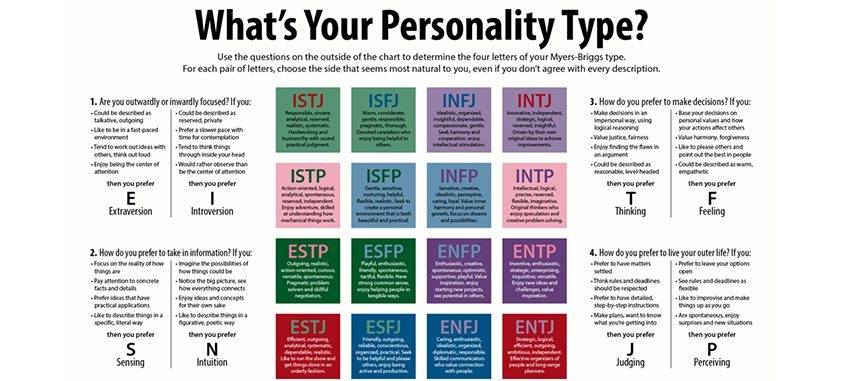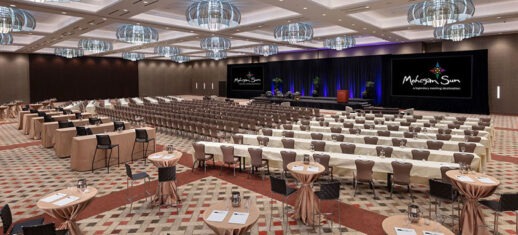There’s a reason savvy planners offer plenty of choices to attendees—from workshops they want to attend, to what they want for lunch and how they want to give feedback. Every person is unique. For a primer on how to engage with different personality types that can be expected at a conference, we turned to The Myers-Briggs Type Indicator model. It features traits from extraversion to introversion and judging to sensing. We’ve compiled a list of the eight types you may encounter at your next event and some tips on how to ensure each one is getting the value they need out of the experience.

The Social Butterfly-Extroversion
Who they are: This is the person making friends at the banquet and in line for the bathrooms. They’re not afraid to start a conversation with anyone, but they understand the line between connecting and annoying. They come prepared with business cards and their elevator pitch, and they know how to foster relationships when the event has come to its close.
How to engage them: Networking and cocktail hours are Social Butterflies’ best friends. By giving these attendees an outlet for their chatty tendencies, you may be able to limit their need to talk their way through a speaker’s presentation.
The benefit: These social hours will also benefit other attendees slower to converse, helping you to kill two birds with one stone.
The Wallflower-Introversion
Who they are: The Wallflower isn’t disengaged, rude or ignoring the presentation—they just prefer to stay in the background. They’re equally as invested as Social Butterflies and attentive to everything they hear. The cocktail hour is the most intimidating part of the event, and groups aren’t their forte.
How to engage them: Encourage one-on-one time with experts during social hours or following their presentations. With less pressure to deliver the perfect question and more time to have an intimate conversation, your attendee will participate at their comfort level.
The benefit: One-on-one time with the professionals can be useful to anyone, especially those who may not have had time to ask a question or have ideas they want opinions on. Everyone will feel heard and fulfilled.
The Realist–Sensing
Who they are: This is the last person you’ll find with their head in the clouds. They believe in the cold hard facts; they want statistics and evidence to support any statements. They appreciate learning from experience rather than hearing hypotheticals and attend panels with those who have accomplished what the Realist hopes to achieve as well.
How to engage them: Place emphasis on experts who have been there, done that. The Realist learns best from those who can make a claim and back it up, both statistically and experientially. You can help teach the Realist by allowing them to gather the facts and then putting together the big picture themselves.
The benefit: You can never go wrong by stating the facts—everybody likes numbers that add substance to a speech, and any surprising statistics will stick.
The Daydreamer–Intuition
Who they are: The opposite of the Realist, Daydreamers look at the big picture first and foremost, then find the facts that help to support their goals. They have plenty of dreams and ambitions, but they occasionally feel overwhelmed by what it will take to achieve them.
How to engage them: Daydreamers will also benefit from one-on-one time with an expert, and a panel or keynote speaker that details how to achieve success will draw in the attendee. By emphasizing that accomplishments are within reach, the Daydreamer will feel reinvigorated and inspired to start tackling any obstacles in their way.
The benefit: An uplifting keynote speaker will not only encourage Daydreamers to triumph—optimism rubs off on everyone, especially when surrounded by those with similar desires of success. It will leave everyone in a positive mood.
The Spy–Thinking
Who they are: The Spy is there to see what their competitors are doing. They are the analytical person companies send to events to size up the competition. They remain fair when judging where the competitors succeed—and where they falter. They can occasionally be seen as indifferent rather than impartial.
How to engage them: Be transparent. Spies will appreciate when you acknowledge a mistake and correct it, rather than try to cover it up—no matter how impartial they are. Put your best foot forward and demonstrate what you’re capable of, but don’t panic if something goes awry. The Spy will make a note of it if you’re graceful when handling a mistake, especially if their company acts less so.
The benefit: Being transparent ups your credibility among all attendees. No one wants to feel confused or lied to; by being transparent (and responsive), people are more likely to forgive a faux pas.
The People-Person-Feeling
Who they are: While similar to the Social Butterfly, the People-Person is less about becoming friends with everybody in the room and more focused on keeping the peace. They want to make sure everyone is comfortable and having a good time. They can be overly tactful and expend energy on others’ experiences rather than their own.
How to engage them: Have check-ins with your attendees regularly. If you take initiative, the People-Person will feel less inclined to play host or hostess and focus on their own experience, rather than how others’ are responding to the panel discussion.
The benefit: By checking in with guests regularly, you can gauge how well your event is going and find any blips that may put a damper on the experience. (Social media is especially useful for this.)
The Hard Worker-Judging
Who they are: Hard Workers are enchanted by their to-do lists, and they believe you must work hard before you can play. They’ll make the most of your event by choosing specific workshops they want to attend for one specific purpose or nugget of information. They tend to be extremely organized because they need to feel in control.
How to engage: Have solid times for each of your presentations, a set agenda and a place where any questions can be answered. Having multiple speakers, workshops and panels is encouraged due to the amount of knowledge you can spread, covering many of the Hard Worker’s interests. Make sure speakers stay on time to avoid accidental overlapping.
The benefit: When you have your ducks in a row, attendees feel confident in your abilities, and you’ll feel less stress knowing all your bases are covered.
The Knowledge-Seeker–Perceiving
Who they are: A notebook and pen are constantly in the hands of a Knowledge-Seeker. They’re looking forward to learning as much as they can from the top experts. They will attend every workshop and keynote speech they can fit into their schedule and are open to any information they can get their hands on.
How to engage them: By putting together an agenda filled with information, you’ve already enhanced the Knowledge-Seeker’s experience. When scheduling panels and workshops with professionals, consider limiting the speakers’ time to allow questions from the audience.
The benefit: Other attendees most likely have questions. Even if they aren’t as prepared as the Knowledge-Seeker, they’ll still be able to learn about something that piques their interest




